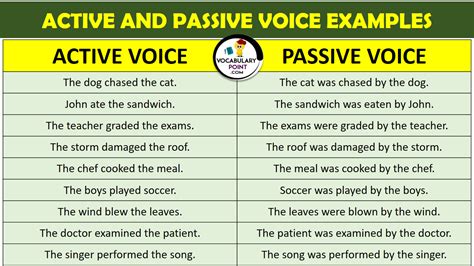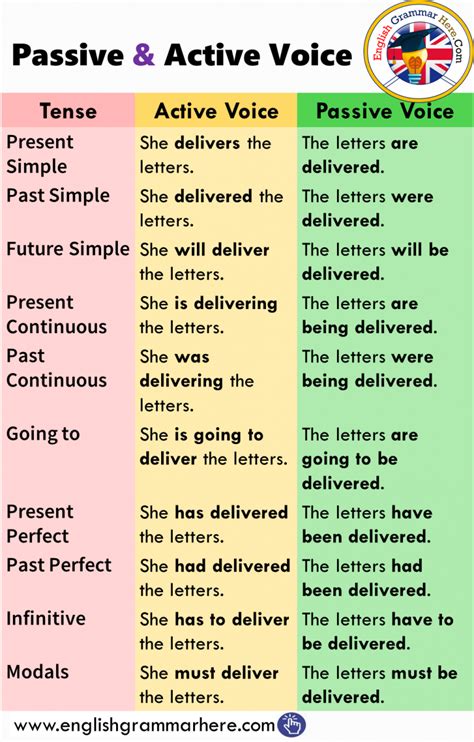Active Vs Passive Voice

The debate between active and passive voice has been a longstanding one in the realm of language and grammar. The choice between these two voices can significantly impact the tone, clarity, and overall effectiveness of written communication. In this article, we will delve into the nuances of active and passive voice, exploring their definitions, usage, and implications for writers and readers alike.
Understanding Active and Passive Voice

The active voice is a grammatical construction in which the subject of a sentence performs the action described by the verb. For example, “The manager wrote the report” is an active voice sentence, where the subject (the manager) is performing the action (writing the report). On the other hand, the passive voice is a construction in which the subject of a sentence receives the action described by the verb. Using the same example, “The report was written by the manager” is a passive voice sentence, where the subject (the report) is receiving the action (being written).
Key Differences and Implications
A key difference between active and passive voice is the level of agency and clarity they convey. Active voice tends to be more direct and engaging, as it clearly states who is performing the action. In contrast, passive voice can sometimes lead to ambiguity or vagueness, as the doer of the action may be unclear or omitted. For instance, “The ball was thrown” (passive voice) does not specify who threw the ball, whereas “John threw the ball” (active voice) clearly identifies the person performing the action.
| Voice | Example | Agency and Clarity |
|---|---|---|
| Active | The chef cooked the meal | High agency and clarity |
| Passive | The meal was cooked | Lower agency and clarity |

When to Use Active and Passive Voice

While active voice is generally preferred for its clarity and directness, there are situations where passive voice is more appropriate or even necessary. For example, in scientific or technical writing, passive voice is often used to emphasize the process or the outcome rather than the person performing the action. In such contexts, passive voice can help maintain objectivity and focus on the facts. Additionally, passive voice can be used to avoid blame or to create a sense of detachment, which can be useful in certain types of writing, such as formal reports or diplomatic communications.
Strategic Use of Voice in Writing
Strategic use of active and passive voice can add variety and nuance to your writing. By alternating between the two voices, you can create a more dynamic and engaging text that keeps the reader interested. Moreover, mastering the use of voice can help you adapt your writing style to different audiences, purposes, and contexts, making your communication more effective and versatile.
Key Points
- The choice between active and passive voice can impact the tone, clarity, and effectiveness of written communication.
- Active voice is generally more direct and engaging, while passive voice can be more ambiguous or vague.
- Passive voice is often used in scientific or technical writing to emphasize the process or outcome.
- Strategic use of voice can add variety and nuance to writing, making it more dynamic and engaging.
- Mastery of active and passive voice can help writers adapt their style to different audiences, purposes, and contexts.
Conclusion and Future Directions
In conclusion, understanding the differences between active and passive voice, as well as their implications for writing, is crucial for effective communication. By recognizing the appropriate contexts for each voice and using them strategically, writers can enhance the clarity, engagement, and overall quality of their work. As language and communication continue to evolve, the nuanced use of active and passive voice will remain an essential skill for writers seeking to convey their ideas with precision and impact.
What is the main difference between active and passive voice?
+The main difference between active and passive voice is the level of agency and clarity they convey. Active voice clearly states who is performing the action, whereas passive voice may omit or make the doer of the action unclear.
When should I use passive voice in writing?
+Passive voice is often used in scientific or technical writing to emphasize the process or outcome rather than the person performing the action. It can also be used to avoid blame or to create a sense of detachment in formal or diplomatic communications.
How can I strategically use active and passive voice in my writing?
+By alternating between active and passive voice, you can create a more dynamic and engaging text. Consider the context, audience, and purpose of your writing, and use voice to add variety, nuance, and clarity to your message.



